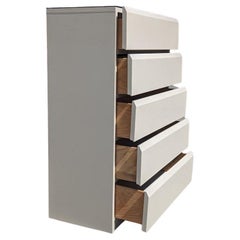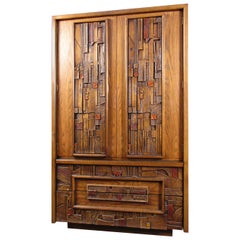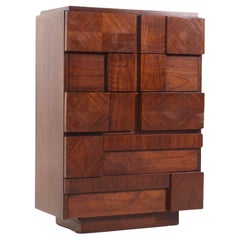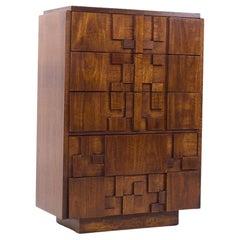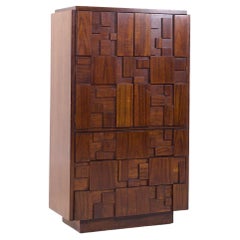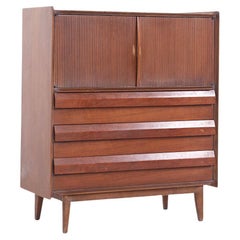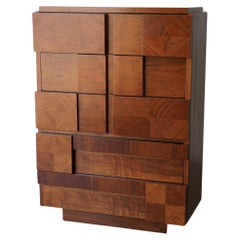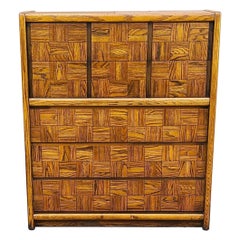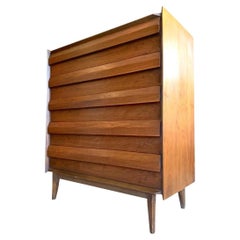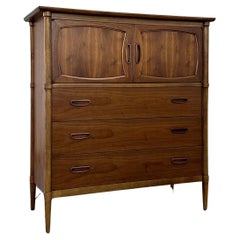Lane Highboy
Late 20th Century Unknown Post-Modern Dressers
Laminate, Wood
Mid-20th Century American Mid-Century Modern Dressers
Walnut
Mid-20th Century American Brutalist Dressers
Wood
Vintage 1970s American Mid-Century Modern Dressers
Walnut
Vintage 1970s American Mid-Century Modern Dressers
Chrome
Vintage 1970s American Mid-Century Modern Dressers
Walnut
Vintage 1970s American Mid-Century Modern Wardrobes and Armoires
Walnut
Vintage 1970s American Mid-Century Modern Dressers
Walnut
Vintage 1970s American Mid-Century Modern Dressers
Walnut
Vintage 1970s Mid-Century Modern Dressers
Wood
Mid-20th Century American Mid-Century Modern Dressers
Walnut
Vintage 1960s American Mid-Century Modern Dressers
Walnut
Vintage 1960s American Mid-Century Modern Dressers
Cane, Walnut
Vintage 1960s American Mid-Century Modern Commodes and Chests of Drawers
Wood, Walnut
Recent Sales
Vintage 1960s Mid-Century Modern Dressers
Walnut
Vintage 1960s American Mid-Century Modern Furniture
Vintage 1970s American Mid-Century Modern Dressers
Burl
Mid-20th Century American Mid-Century Modern Dressers
Wood
Mid-20th Century American Mid-Century Modern Dressers
Wood
Mid-20th Century American Mid-Century Modern Dressers
Laminate, Wood, Walnut, Lacquer
Vintage 1970s American Mid-Century Modern Dressers
Walnut
Vintage 1970s North American Mid-Century Modern Dressers
Wood
Vintage 1970s American Mid-Century Modern Dressers
Brass
Vintage 1970s American Mid-Century Modern Dressers
Wood
Vintage 1970s American Mid-Century Modern Dressers
Walnut
Vintage 1970s American Mid-Century Modern Commodes and Chests of Drawers
Vintage 1960s American Mid-Century Modern Dressers
Chrome
Vintage 1960s American Mid-Century Modern Dressers
Walnut
Vintage 1960s American Mid-Century Modern Dressers
Walnut
Vintage 1970s American Mid-Century Modern Dressers
Walnut
Mid-20th Century American Mid-Century Modern Dressers
Brass
Mid-20th Century American Mid-Century Modern Dressers
Walnut
Vintage 1970s American Brutalist Dressers
Walnut
Vintage 1970s American Mid-Century Modern Dressers
Wood, Walnut
Vintage 1970s American Mid-Century Modern Dressers
Walnut
Vintage 1970s Mid-Century Modern Wardrobes and Armoires
Wood
Vintage 1960s American Mid-Century Modern Cabinets
Wood, Burl
Vintage 1970s American Mid-Century Modern Dressers
Wood
Mid-20th Century American Mid-Century Modern Dressers
Brass
Vintage 1960s American Mid-Century Modern Dressers
Chrome
Vintage 1970s American Mid-Century Modern Dressers
Wood
Vintage 1970s American Mid-Century Modern Wardrobes and Armoires
Walnut
Vintage 1970s American Mid-Century Modern Wardrobes and Armoires
Walnut
Vintage 1970s American Mid-Century Modern Wardrobes and Armoires
Wood
Vintage 1970s American Mid-Century Modern Dressers
Oak
Vintage 1970s American Mid-Century Modern Wardrobes and Armoires
Walnut
Vintage 1960s American Mid-Century Modern Dressers
Wood
Vintage 1960s American Mid-Century Modern Wardrobes and Armoires
Ash
Vintage 1950s American Mid-Century Modern Dressers
Walnut
Vintage 1970s American Mid-Century Modern Dressers
Brass
Vintage 1970s American Mid-Century Modern Dressers
Rosewood, Walnut
Vintage 1970s Mid-Century Modern Bedroom Sets
Wood
Vintage 1970s American Mid-Century Modern Wardrobes and Armoires
Burl
Vintage 1970s American Mid-Century Modern Dressers
Wood
Vintage 1970s American Brutalist Dressers
Oak
Vintage 1970s American Mid-Century Modern Dressers
Walnut
Vintage 1970s American Mid-Century Modern Dressers
Walnut
Vintage 1970s American Mid-Century Modern Wardrobes and Armoires
Wood
Vintage 1970s American Mid-Century Modern Dressers
Chrome
Mid-20th Century American Mid-Century Modern Dressers
Walnut
Vintage 1970s American Brutalist Dressers
Walnut
Vintage 1970s Brutalist Dressers
Walnut
Vintage 1970s American Mid-Century Modern Dressers
Burl
Vintage 1960s American Mid-Century Modern Dressers
Wood, Walnut
Vintage 1960s American Brutalist Dressers
Walnut
Mid-20th Century American Mid-Century Modern Dressers
Wood
Vintage 1970s American Mid-Century Modern Dressers
Burl
Vintage 1960s American Mid-Century Modern Dressers
Walnut
Vintage 1950s American Mid-Century Modern Commodes and Chests of Drawers
Walnut
Mid-20th Century American Mid-Century Modern Dressers
Walnut
Vintage 1970s Italian Mid-Century Modern Lounge Chairs
Fabric
Vintage 1960s American Mid-Century Modern Commodes and Chests of Drawers
Aluminum
People Also Browsed
2010s Danish Scandinavian Modern Dining Room Chairs
Oak
21st Century and Contemporary Belgian Side Tables
Sandstone
21st Century and Contemporary Mexican Mid-Century Modern Table Lamps
Wood, Fabric, Linen, Fiberglass
2010s French Modern Chandeliers and Pendants
Ceramic
2010s British Scandinavian Modern Tables
Mohair, Oak
2010s Danish Scandinavian Modern Dining Room Chairs
Oak
2010s Mexican Modern Armchairs
Upholstery, Hardwood
2010s South African Modern Side Tables
Copper, Steel
21st Century and Contemporary German Mid-Century Modern Chandeliers and ...
Metal, Iron
2010s Belgian Modern Club Chairs
Linen
Vintage 1970s Canadian Night Stands
Wood
2010s German Mid-Century Modern Chandeliers and Pendants
Brass
2010s Italian Modern Chandeliers and Pendants
Metal, Brass
2010s Bosnian Mid-Century Modern Daybeds
Fabric, Beech, Velvet
21st Century and Contemporary Italian Mid-Century Modern Chandeliers and...
Brass
Antique 1760s English George III Dressers
Mahogany
Lane Highboy For Sale on 1stDibs
How Much is a Lane Highboy?
Lane Furniture for sale on 1stDibs
When the first iteration of the Lane Furniture company began to produce its now-famous Lane cedar chests in the early 20th century, the family behind the brand was unsure of how successful they’d be, so they initially didn’t bother adding their name to the offerings.
The manufacturer was off to a modest start but the family was industrious: The Lanes were made up of farmers and contractors who’d built more than 30 miles of the Virginian railroad. They owned a cotton mill and purchased thousands of acres of land in Campbell County, Virginia, where the Virginian railroad was intended to cross the main line of the Southern Railway.
The Lanes hoped to start a town in this region of the state, and by 1912, streets for the town of Altavista had been laid out and utility lines were installed. In the spring of that year, John Lane purchased a defunct box factory at a bankruptcy auction. His son, Edward Hudson Lane, was tasked with the manufacturing of the cedar “hope” chests for which the Lane family would become known, even though the company was initially incorporated as the Standard Red Cedar Chest Company.
The Standard Red Cedar Chest Company struggled in its early days but introduced an assembly system at its small factory after securing a contract with the federal government to produce ammunition boxes made of pine during World War I. The company prospered and applied mass-production methods to its cedar-chest manufacturing after the war, and, in 1922, rebranding as the Lane Company, it implemented a national advertising campaign to market its products.
Ads tied the company’s strong cedar hope chests to romance. Anchored by copy that read “The gift that starts the home,” the campaign rendered a Lane cedar chest a necessary purchase for young women to store linens, clothing and keepsakes as they prepared to marry.
Wartime production during World War II had Lane producing aircraft parts. In the 1950s, the family-owned company began to branch out into manufacturing tables, bedroom pieces and other various furnishings for the entire home. Today, the brand’s vintage mid-century furniture — which includes the Perception, Tuxedo and Acclaim collections — is highly sought after.
Designed by Andre Bus, Lane’s Acclaim furniture collection of coffee tables, end tables, dressers and more has been compared to Drexel’s wildly popular Declaration series for its blend of traditional craftsmanship and the impeccably clean contours that are frequently associated with the best of mid-century modern design.
Ads for the Acclaim line suggested that it included “probably the best-selling table in the world.” Before its offerings expanded to include items for the bedroom and dining room, Lane was primarily known for its tables and case pieces — there are side tables, coffee tables and more created by Bus in the Acclaim collection, each sporting graceful tapered legs and dovetail inlays.
Later, during the 1960s, Lane offered handsome modular wall units created by the likes of Paul McCobb, an award-winning Massachusetts-born designer best known for his work at Directional.
The company was acquired by United Furniture Industries in 2017 and became particularly well-known among contemporary consumers for its upholstered furniture. In 2022 United abruptly closed and ceased operations at Lane.
Vintage Lane furniture is generally characterized by relatively neutral styles, which are versatile in different kinds of interiors, as well as good quality woods and careful manufacturing. All of these attributes have made Lane one of the most recognizable names in American furniture.
Browse storage cabinets, side tables and other vintage Lane furniture on 1stDibs.
A Close Look at Mid-century Modern Furniture
Organically shaped, clean-lined and elegantly simple are three terms that well describe vintage mid-century modern furniture. The style, which emerged primarily in the years following World War II, is characterized by pieces that were conceived and made in an energetic, optimistic spirit by creators who believed that good design was an essential part of good living.
ORIGINS OF MID-CENTURY MODERN FURNITURE DESIGN
- Emerged during the mid-20th century
- Informed by European modernism, Bauhaus, International style, Scandinavian modernism and Frank Lloyd Wright’s architecture
- A heyday of innovation in postwar America
- Experimentation with new ideas, new materials and new forms flourished in Scandinavia, Italy, the former Czechoslovakia and elsewhere in Europe
CHARACTERISTICS OF MID-CENTURY MODERN FURNITURE DESIGN
- Simplicity, organic forms, clean lines
- A blend of neutral and bold Pop art colors
- Use of natural and man-made materials — alluring woods such as teak, rosewood and oak; steel, fiberglass and molded plywood
- Light-filled spaces with colorful upholstery
- Glass walls and an emphasis on the outdoors
- Promotion of functionality
MID-CENTURY MODERN FURNITURE DESIGNERS TO KNOW
- Charles and Ray Eames
- Eero Saarinen
- Milo Baughman
- Florence Knoll
- Harry Bertoia
- Isamu Noguchi
- George Nelson
- Danish modernists Hans Wegner and Arne Jacobsen, whose emphasis on natural materials and craftsmanship influenced American designers and vice versa
ICONIC MID-CENTURY MODERN FURNITURE DESIGNS
- Eames lounge chair
- Nelson daybed
- Florence Knoll sofa
- Egg chair
- Womb chair
- Noguchi coffee table
- Barcelona chair
VINTAGE MID-CENTURY MODERN FURNITURE ON 1STDIBS
The mid-century modern era saw leagues of postwar American architects and designers animated by new ideas and new technology. The lean, functionalist International-style architecture of Le Corbusier and Bauhaus eminences Ludwig Mies van der Rohe and Walter Gropius had been promoted in the United States during the 1930s by Philip Johnson and others. New building techniques, such as “post-and-beam” construction, allowed the International-style schemes to be realized on a small scale in open-plan houses with long walls of glass.
Materials developed for wartime use became available for domestic goods and were incorporated into mid-century modern furniture designs. Charles and Ray Eames and Eero Saarinen, who had experimented extensively with molded plywood, eagerly embraced fiberglass for pieces such as the La Chaise and the Womb chair, respectively.
Architect, writer and designer George Nelson created with his team shades for the Bubble lamp using a new translucent polymer skin and, as design director at Herman Miller, recruited the Eameses, Alexander Girard and others for projects at the legendary Michigan furniture manufacturer.
Harry Bertoia and Isamu Noguchi devised chairs and tables built of wire mesh and wire struts. Materials were repurposed too: The Danish-born designer Jens Risom created a line of chairs using surplus parachute straps for webbed seats and backrests.
The Risom lounge chair was among the first pieces of furniture commissioned and produced by celebrated manufacturer Knoll, a chief influencer in the rise of modern design in the United States, thanks to the work of Florence Knoll, the pioneering architect and designer who made the firm a leader in its field. The seating that Knoll created for office spaces — as well as pieces designed by Florence initially for commercial clients — soon became desirable for the home.
As the demand for casual, uncluttered furnishings grew, more mid-century furniture designers caught the spirit.
Classically oriented creators such as Edward Wormley, house designer for Dunbar Inc., offered such pieces as the sinuous Listen to Me chaise; the British expatriate T.H. Robsjohn-Gibbings switched gears, creating items such as the tiered, biomorphic Mesa table. There were Young Turks such as Paul McCobb, who designed holistic groups of sleek, blond wood furniture, and Milo Baughman, who espoused a West Coast aesthetic in minimalist teak dining tables and lushly upholstered chairs and sofas with angular steel frames.
Generations turn over, and mid-century modern remains arguably the most popular style going. As the collection of vintage mid-century modern chairs, dressers, coffee tables and other furniture for the living room, dining room, bedroom and elsewhere on 1stDibs demonstrates, this period saw one of the most delightful and dramatic flowerings of creativity in design history.
Finding the Right Dressers for You
Antique, new and vintage dressers are a staple in any household. Whether it’s a 19th-century solid pine or oak Welsh kitchen dresser you’re using to store tableware or a Broyhill Brasilia highboy in your bedroom, these furniture fixtures are essential for making the most of your space.
The first step in finding the perfect dresser is considering your particular needs. Most tall dressers offer anywhere from five to seven drawers, essentially allowing for the organization of an entire wardrobe, while shorter, waist-height dresser varieties can be equipped with a convenient vanity mirror.
A highboy dresser is usually around six feet tall, with some versions standing even taller at seven feet or so. Highboys, which began to appear with frequency during the early 17th century in England, are essentially very tall dressers with lots of drawers, whereas a lowboy is a different type of storage furniture in that it's a dressing table with one or two rows of drawers.
When shopping for your antique or vintage dresser, consider those that bear the hallmarks of solid construction. Good furniture means making an investment, and solid hardwood pieces of maple, walnut or cherry will prove far more durable than a bedroom dresser made of particleboard.
If you’re looking for a mid-century modern case piece that boasts a subdued pairing of wood grains and uncomplicated drawer pulls, browse elegant dressers designed by Florence Knoll, Harvey Probber, Paul McCobb and other furniture makers associated with the celebrated style on 1stDibs.
Dressers characterized by bolder designs are also popular: Not only will your new piece of furniture be a storage solution, but it'll also make a statement.
Art Deco furniture makers preferred to work with dark woods and typically incorporated decorative embellishments. An ornately carved French or Italian Art Deco dresser complete with vanity mirror and cabriole scrolled feet might better complement the other pieces in your home. Alternatively, if you favor sumptuous antique furniture with curving lines and floral flourishes, the collection on 1stDibs also includes sophisticated 1800s-era Victorian walnut dressers and washstands with marble tops.
After all, a good case piece isn’t merely for minimizing clutter in your space. The style of your chosen dresser and its specific attributes should add something to your decor and your home. Modern creations include one-of-a-kind shapes, like the venturesome chests of drawers in leather, marble and wood crafted by the likes of Roberto Cavalli.
Explore a broad array of antique and vintage dressers today on 1stDibs.
- 1stDibs ExpertMarch 13, 2024United Furniture took over Lane Furniture in 2017. After that, the furniture maker became well known among contemporary consumers for its upholstered furniture. In 2022, United abruptly closed and ceased operations at Lane due to financial problems. Find a collection of Lane Furniture pieces from some of the world's top sellers on 1stDibs.
- 1stDibs ExpertMarch 13, 2024Yes, Lane Furniture was made in the USA. The American furniture maker produced most of its pieces at factories located in North Carolina and Mississippi. However, Lane Furniture stopped manufacturing pieces in 2022. Shop a large selection of Lane furniture from some of the world's top sellers on 1stDibs.
